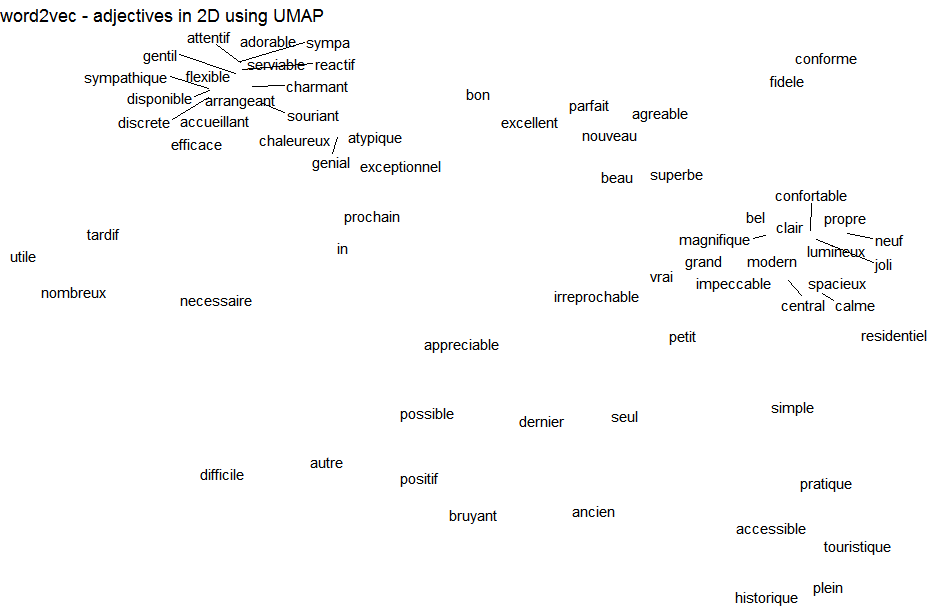
The hardware and bandwidth for this mirror is donated by dogado GmbH, the Webhosting and Full Service-Cloud Provider. Check out our Wordpress Tutorial.
If you wish to report a bug, or if you are interested in having us mirror your free-software or open-source project, please feel free to contact us at mirror[@]dogado.de.
This repository contains an R package allowing to build a word2vec model
install.packages("word2vec")remotes::install_github("bnosac/word2vec")Look to the documentation of the functions
help(package = "word2vec")library(udpipe)
data(brussels_reviews, package = "udpipe")
x <- subset(brussels_reviews, language == "nl")
x <- tolower(x$feedback)library(word2vec)
set.seed(123456789)
model <- word2vec(x = x, type = "cbow", dim = 15, iter = 20)
embedding <- as.matrix(model)
embedding <- predict(model, c("bus", "toilet"), type = "embedding")
lookslike <- predict(model, c("bus", "toilet"), type = "nearest", top_n = 5)
lookslike
$bus
term1 term2 similarity rank
bus gratis 0.9959141 1
bus tram 0.9898559 2
bus voet 0.9882312 3
bus ben 0.9854795 4
bus auto 0.9839599 5
$toilet
term1 term2 similarity rank
toilet koelkast 0.9870380 1
toilet douche 0.9850463 2
toilet werkte 0.9843599 3
toilet slaapkamers 0.9802811 4
toilet eigen 0.9759347 5write.word2vec(model, "mymodel.bin")
model <- read.word2vec("mymodel.bin")
terms <- summary(model, "vocabulary")
embedding <- as.matrix(model)
library(udpipe)
data(brussels_reviews_anno, package = "udpipe")
x <- subset(brussels_reviews_anno, language == "fr" & !is.na(lemma) & nchar(lemma) > 1)
x <- subset(x, xpos %in% c("NN", "IN", "RB", "VB", "DT", "JJ", "PRP", "CC",
"VBN", "NNP", "NNS", "PRP$", "CD", "WP", "VBG", "UH", "SYM"))
x$text <- sprintf("%s//%s", x$lemma, x$xpos)
x <- paste.data.frame(x, term = "text", group = "doc_id", collapse = " ")
model <- word2vec(x = x$text, dim = 15, iter = 20, split = c(" ", ".\n?!"))
embedding <- as.matrix(model)library(uwot)
viz <- umap(embedding, n_neighbors = 15, n_threads = 2)
## Static plot
library(ggplot2)
library(ggrepel)
df <- data.frame(word = gsub("//.+", "", rownames(embedding)),
xpos = gsub(".+//", "", rownames(embedding)),
x = viz[, 1], y = viz[, 2],
stringsAsFactors = FALSE)
df <- subset(df, xpos %in% c("JJ"))
ggplot(df, aes(x = x, y = y, label = word)) +
geom_text_repel() + theme_void() +
labs(title = "word2vec - adjectives in 2D using UMAP")
## Interactive plot
library(plotly)
plot_ly(df, x = ~x, y = ~y, type = "scatter", mode = 'text', text = ~word)library(word2vec)
model <- read.word2vec(file = "cb_ns_500_10.w2v", normalize = TRUE)predict(model, newdata = c("fries", "money"), type = "nearest", top_n = 5)
$fries
term1 term2 similarity rank
fries burgers 0.7641346 1
fries cheeseburgers 0.7636056 2
fries cheeseburger 0.7570285 3
fries hamburgers 0.7546136 4
fries coleslaw 0.7540344 5
$money
term1 term2 similarity rank
money funds 0.8281102 1
money cash 0.8158758 2
money monies 0.7874741 3
money sums 0.7648080 4
money taxpayers 0.7553093 5wv <- predict(model, newdata = c("king", "man", "woman"), type = "embedding")
wv <- wv["king", ] - wv["man", ] + wv["woman", ]
predict(model, newdata = wv, type = "nearest", top_n = 3)
term similarity rank
king 0.9479475 1
queen 0.7680065 2
princess 0.7155131 3wv <- predict(model, newdata = c("belgium", "government"), type = "embedding")
predict(model, newdata = wv["belgium", ] + wv["government", ], type = "nearest", top_n = 2)
term similarity rank
netherlands 0.9337973 1
germany 0.9305047 2
predict(model, newdata = wv["belgium", ] - wv["government", ], type = "nearest", top_n = 1)
term similarity rank
belgium 0.9759384 1wv <- predict(model, newdata = c("black", "white", "racism", "person"), type = "embedding")
wv <- wv["white", ] - wv["person", ] + wv["racism", ]
predict(model, newdata = wv, type = "nearest", top_n = 10)
term similarity rank
black 0.9480463 1
racial 0.8962515 2
racist 0.8518659 3
segregationists 0.8304701 4
bigotry 0.8055548 5
racialized 0.8053641 6
racists 0.8034531 7
racially 0.8023036 8
dixiecrats 0.8008670 9
homophobia 0.7886864 10
wv <- predict(model, newdata = c("black", "white"), type = "embedding")
wv <- wv["black", ] + wv["white", ]
predict(model, newdata = wv, type = "nearest", top_n = 3)
term similarity rank
blue 0.9792663 1
purple 0.9520039 2
colored 0.9480994 3library(quanteda)
library(word2vec)
data("data_corpus_inaugural", package = "quanteda")
toks <- data_corpus_inaugural %>%
corpus_reshape(to = "sentences") %>%
tokens(remove_punct = TRUE, remove_symbols = TRUE) %>%
tokens_tolower() %>%
as.list()
set.seed(54321)
model <- word2vec(toks, dim = 25, iter = 20, min_count = 3, type = "skip-gram", lr = 0.05)
emb <- as.matrix(model)
predict(model, c("freedom", "constitution", "president"), type = "nearest", top_n = 5)
$freedom
term1 term2 similarity rank
freedom human 0.9094619 1
freedom man 0.9001195 2
freedom life 0.8840834 3
freedom generations 0.8676646 4
freedom mankind 0.8632550 5
$constitution
term1 term2 similarity rank
constitution constitutional 0.8814662 1
constitution conformity 0.8810275 2
constitution authority 0.8786194 3
constitution prescribed 0.8768463 4
constitution states 0.8661923 5
$president
term1 term2 similarity rank
president clinton 0.9552274 1
president clergy 0.9426718 2
president carter 0.9386149 3
president chief 0.9377645 4
president reverend 0.9347451 5library(tokenizers.bpe)
library(word2vec)
data(belgium_parliament, package = "tokenizers.bpe")
x <- subset(belgium_parliament, language == "french")
x <- x$text
tokeniser <- bpe(x, coverage = 0.999, vocab_size = 1000, threads = 1)
toks <- bpe_encode(tokeniser, x = x, type = "subwords")
toks <- bpe_encode(tokeniser, x = x, type = "ids")
model <- word2vec(toks, dim = 25, iter = 20, min_count = 3, type = "skip-gram", lr = 0.05)
emb <- as.matrix(model)Need support in text mining? Contact BNOSAC: http://www.bnosac.be
These binaries (installable software) and packages are in development.
They may not be fully stable and should be used with caution. We make no claims about them.
Health stats visible at Monitor.